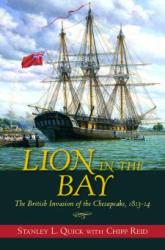 Pirates and Privateers Pirates and Privateers
The History of Maritime
Piracy
Cindy Vallar, Editor
& Reviewer
P.O. Box 425,
Keller, TX 76244-0425
    
Books for
Adults ~ History: Navy (United States & United
Kingdom)

Lion in the Bay: The British
Invasion of the Chesapeake, 1813-1814
by Stanley L. Quick with Chipp Reid
Naval Institute Press, 2015, ISBN 978-1-61251-236-5, US
$32.95
Also available in other formats
    
A naval
architect and marine engineer, Dr. Stanley Quick
began researching the War of 1812 after he and his
wife purchased an historic home on Maryland’s
Eastern Shore. His focus of study was the British
campaign in the Chesapeake Bay. Although raids and
attacks were made on land bases in Virginia,
Maryland, and Washington, DC, this was primarily a
naval campaign that began in 1813, and ended in
September 1814. He first amassed a collection of
information from primary documents, including copies
of the ships’ logs from every Royal Navy vessel that
participated in the events, from which he wrote his
historical version of the events before reading
other scholars’ conclusions. Unfortunately, he died
before completing his book, so Chipp Reid, a naval
historian, was selected to write the final two
chapters (the burning of Washington and the attacks
on Baltimore) of this story and to edit the
manuscript.
The story of the invasion begins in the last decade
of the 18th century when “Irreconcilable
Differences” erupt between the United States and her
former motherland, Great Britain. One sore point
concerns the impressment of merchant seamen from
American ships, which almost leads to war in the
first decade of the 19th century after HMS Leopard
attacks USS Chesapeake. Cooler heads
prevail until finally, on 18 June 1812, President
James Madison declares war on England. These events
are discussed in the first chapter, and the
divisiveness that separates Federalists from
Democrats is best shown through the lives of two
polar opposites: Captain Charles Gordon of the US
Navy and Alexander C. Hanson, a newspaper editor and
lawyer.
The subsequent nineteen chapters discuss (a) how
woefully unprepared for war the fledgling nation is
when pitted against the battle-hardened Royal Army
and the supremacy of the Royal Navy upon the High
Seas; (b) the British blockade of the North American
coasts and the effect this wooden wall has on the
Chesapeake and the people who live and work there;
(c) the movements of the vessels in both navies, as
well as the privateers who sail from Baltimore; (d)
the ships, raids, attacks, and naval maneuvers
during 1813 and 1814; (e) lesser-known and key
participants in the events, such as Admiral Sir John
Warren, Rear Admiral George Cockburn, Secretary of
War John Armstrong, Secretary of the Navy William
Jones, Vice Admiral Sir Alexander Cochrane, Major
General Robert Ross, Commodore Joshua Barney, and
Major George Armistead; and (f) detailed accounts of
specific battles, including Caulk’s Field, Hampton,
St. Leonard Creek, Bladensburg, and North Point.
Quotations from primary documents, illustrations,
and maps enhance the narrative. Chapter notes, a
bibliography, and an index complete the book.
Aside from a couple minor errors pertaining to which
secretary of the Navy signs orders in 1812, Lion
in the Bay is one of the most detailed,
unbiased, and clearly presented accounts of what
takes place in and around the Chesapeake Bay from
1813 through September 1814. The inclusion of events
in other theaters and locations help to place the
entire war into perspective. Any student of history
who wishes to know more about this time and place
will find this an invaluable, rewarding, and highly
readable resource.
Review
Copyright ©2015 Cindy Vallar

Click to contact me
Background image compliments
of Anke's Graphics |

